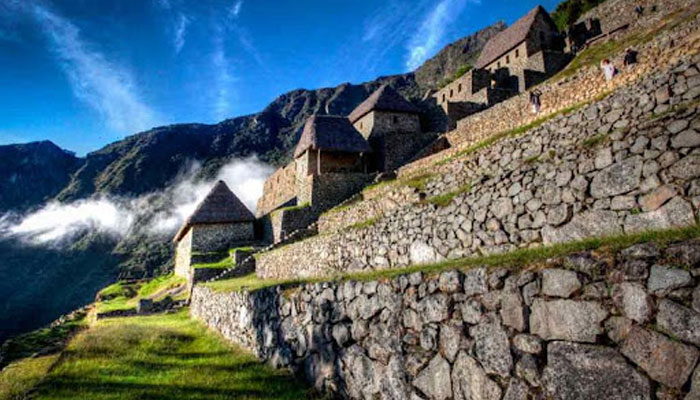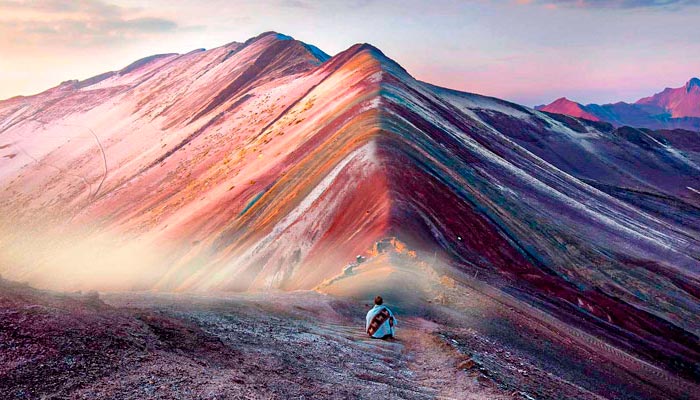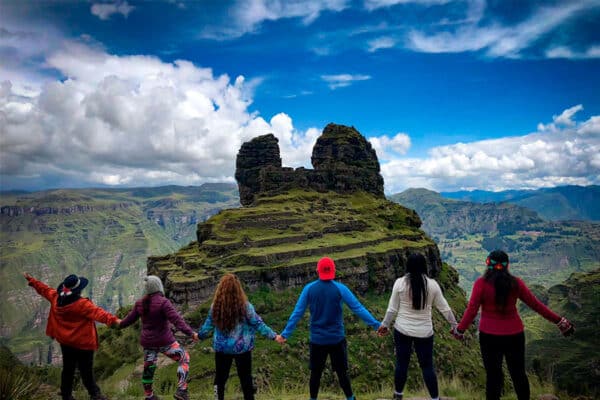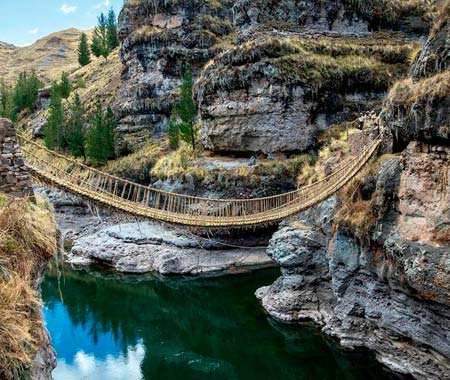Posted on: 21 September 2023
Hiking through the 7 Lakes of Ausangate: An Unmissable Tour in Cusco
If you’re someone who enjoys hiking, this is your chance to explore the 7 Ausangate Lakes, where you can admire the Ausangate Mountain and take a journey through the 7 Ausangate Lakes. This tour begins in the city of Cusco and takes you to the Quispicanchis district, specifically to the town of Tinke and then Pacchanta, where the hike amidst the breathtaking landscape begins.
 The 7 Ausangate Lakes are a beautiful tourist attraction. During this tour, you’ll encounter lakes of turquoise, green, blue, and even reddish hues. You’ll also get to see the Andean flora and fauna, including alpacas, vizcachas, and condors. However, the true highlights are each of the 7 lakes fed by the Ausangate Mountain.
The 7 Ausangate Lakes are a beautiful tourist attraction. During this tour, you’ll encounter lakes of turquoise, green, blue, and even reddish hues. You’ll also get to see the Andean flora and fauna, including alpacas, vizcachas, and condors. However, the true highlights are each of the 7 lakes fed by the Ausangate Mountain.
Turquoise Lakes?
The characteristic turquoise color of the lakes is due to the powdered minerals that are suspended in their waters. This unique feature makes the lakes particularly attractive, especially on sunny days when they glisten under the sunlight.
The Route of the 7 Ausangate Lakes through Ausangate Mountain
The 7 Ausangate Lakes are a collection of lakes that make up this tourist attraction. They are fed by the melting snow from the immense Ausangate Mountain, which stands at an elevation of about 4,500 to 4,800 meters (14,764 to 15,748 feet) above sea level. The local communities decided to utilize this natural beauty to create the circuit of the 7 Ausangate Lakes, which consists of:
Puka Cocha Lake:
Also known as the Chocolate Lake due to its distinctive color, this is the first lake you’ll encounter after approximately 45 minutes of walking from the starting point in the village of Pacchanta.
Pata Cocha Lake:
This is the second lake you’ll come across, with a slightly lighter hue and a size similar to the first lake. It sits at an elevation of 4,860 meters (15,945 feet) above sea level and offers a better view of the Ausangate Mountain.
Alcacocha Lake:
Continuing the hike, you’ll reach the third lake, which also has a color similar to the second lake.
Qomer Cocha Lake:
As you progress on the journey, you’ll encounter the fourth lake, named Qomer Cocha, which translates to “green lake” in English due to its turquoise waters. This lake is situated at an elevation of 4,666 meters (15,312 feet) above sea level and provides one of the best views in the area.
Orco Otorongo Lake:
True to its name, this lake boasts a color resembling the fur of a male otorongo (jaguar).
China Otorongo Lake:
Near the previous lake, you’ll find another one with characteristics reminiscent of an otorongo, this time referring to a female jaguar.
Azul Cocha Lake:
This is the last lake you’ll visit after a long journey through Ausangate and its 7 lakes. This lake is impressive due to the dark blue color of its waters, and its beauty, along with the surrounding mountainous landscape, is highly appreciated by tourists.
Where Are the 7 Ausangate Lakes Located?
The 7 Ausangate Lakes are situated in the Quispicanchis province, Ocongate district, in the town of Pacchanta, at an altitude of 4,200 meters (13,780 feet) above sea level. It’s located approximately 100 kilometers (62 miles) by road from the city of Cusco.
Ausangate Mountain
Ausangate Mountain is considered the twin brother of the Salkantay Mountain in terms of grandeur and size. It is also the second-highest mountain in Cusco and one of the five tallest peaks in Peru. For the Incas, Ausangate was sacred, a divine being that governed the life and death of the people. Many of these beliefs have been preserved to this day. The residents of Cusco still pay homage to each mountain, just as their Inca ancestors did.
What’s the Route to the 7 Ausangate Lakes in Cusco Like?
This is a one-day excursion to the 7 Ausangate Lakes. The trail is well-maintained and marked. Along the route, you’ll find stalls where local women sell water, coca leaves, and other candies. They also take the opportunity to sell their handmade crafts, like alpaca scarves. Consider buying or consuming local products, as this supports the families in the area, who are responsible for preserving this beautiful place. During the hike, you’ll also encounter many vicuñas and llamas, and you’ll pass by a small river that’s part of the path.
Pacchanta’s Thermal Baths
Pacchanta, the town where the 7 Ausangate Lakes hike begins, offers one of the most famous hot springs in Cusco, with a fantastic view of the Ausangate Mountain. These hot springs are fed by the warm waters of the Ausangate Mountain itself. There are only two pools with temperatures ranging from 40°C (104°F). What makes this place wonderful is the view of the Ausangate Mountain while you soak in the thermal waters. Don’t miss this opportunity.
Flora and Fauna in the Ausangate Lakes and Surroundings
Being at such high altitudes naturally means you’ll encounter typical fauna, such as alpacas, llamas, vicuñas, and sheep, all in their natural habitat. You’ll also spot various birds flying overhead. Regarding flora, you’ll come across “Ichu” or grass, which covers the entire area, as well as some wild herbs that grow close to the ground.
Weather on the 7 Ausangate Lakes Tour
As we know, weather can be unpredictable. You might arrive in Pacchanta to find cloudy skies, strong winds, and then suddenly, radiant sunshine with clear blue skies. The weather in this area is highly changeable, so be prepared and bring the necessary gear.
The Best Time for the 7 Ausangate Lakes Hike
The best time to undertake this fantastic hike is during the dry season, which typically runs from April to November. During this time, you’ll have the best views and clear skies. Nevertheless, always be prepared with the right equipment for the hike.
Can I Go on My Own and Do the 7 Ausangate Lakes Circuit?
It’s possible to make this trip from Cusco using local transportation. Buses that cover the Cusco-Ocongate Tinki route can be found near the Tomasa Titto Condemayta Avenue, with the Casa de la Juventud (Youth House) stadium as a reference point. The fare is economical, ranging from PEN 10.00 to PEN 15.00 (approximately $2 to $4 USD).
The journey takes about 3 hours along a well-maintained road. As your final destination, you’ll arrive in the town of Tinke, an appropriate place to purchase all the necessary supplies for your hike. From here, you’ll need to take taxis or cars to the town of Pacchanta, which is about 30 minutes away.
Once in the town of Pacchanta, you can ask for directions to the starting point of the 7 Ausangate Lakes hike. It’s a good idea to bring a map and follow the signs until you reach the 7 lakes and, finally, the viewpoint. From here, you’ll start descending after taking in the breathtaking scenery until you reach Pacchanta. Here, you can choose to relax in the thermal-medicinal waters or return to the city of Cusco.
However, it’s advisable to opt for a tourist agency that facilitates the entire journey and ensures you don’t encounter issues with transportation or other unexpected challenges.
Recommendations for Visiting the 7 Ausangate Lakes
- Being at high altitudes means experiencing colder temperatures. Make sure to carry appropriate gear and clothing.
- Spend at least a couple of days in Cusco to acclimatize and avoid altitude sickness.
- Stay hydrated during your hikes.
What to Bring for the 7 Ausangate Lakes Hike
- 2 liters of water.
- Basic medications.
- Small backpack.
- Snacks (optional).
- Waterproof trekking shoes.
- Thermal clothing (thermal underwear, hat, gloves, and socks).
- Feather jacket or warm jacket.
- Waterproof suit (poncho).
- Hat and sunglasses.
- Sunscreen.
- Toilet paper.
- Extra batteries (there’s no electricity during the hike).
- Swimsuit and towel (in case you want to visit the hot springs).
- Extra cash, preferably in Peruvian soles.
Visiting the 7 Ausangate Lakes is an incredible adventure that will take you through some of the most stunning natural landscapes in Peru. With the right preparations and equipment, you’ll have a memorable experience exploring these breathtaking high-altitude lakes. Enjoy your journey!











Share the Adventure! Inspire, Bookmark, and Connect with Fellow Travelers
Share on FacebookShare
Share on Twitter Share
Share on whatsapp Share